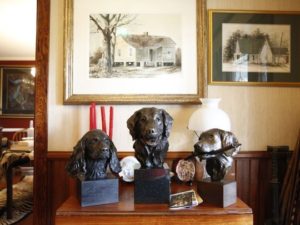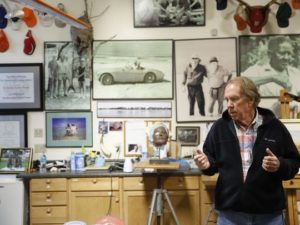Dean’s Advisory Board Member, Sandy Proctor, Featured in Tallahassee Democrat
Article courtesy of Tallahassee Democrat. Written by Marina Brown.
Children don’t usually stay out playing after dark. Nor do old men sit on benches in the driving rain. Bobby Bowden doesn’t usually call signals throughout the night. And puppies tire of playing and grow up into dogs.
But not in the world created by Tallahassee sculptor, W. Stanley “Sandy” Proctor. Where Proctor lives, the ideal is made matter. And not just any matter. It is carved, made into clay and cast into bronze. Yet in that hard “inanimacy” of metal, Sandy Proctor captures the ephemeral moment — when the widow’s world lies broken, a dog’s plea for a game of catch runs high, when a dancer defies gravity as he prepares to push off from the earth.
Sandy Proctor, who has more than a dozen sculptures on display in and around Tallahassee, recently gifted the FSU College of Fine Arts’ School of Dance with just such a piece, a larger-than-life sculpture called, “Enchanter,” portraying the famous Russian ballet dancer, Rudolf Nureyev. Josephine Garibaldi, the School’s Chair, expressed her delight at the artistic addition at an early December dedication.
The sculpture’s new home is surrounded by flowers on a marble pedestal in a specially created garden at the rear of the School of Dance in Montgomery Hall. Here, Nureyev powers off from muscular legs, his torso and arms in ethereal flight. That sculpture and hundreds of others across the nation in museums, government and institutional settings, and private collections are part of the nearly 50 years’ body of work of a man who chose not to leave Tallahassee, but whose talent brought the art world calling on him.

A work in progress pictured in Sandy Proctor’s studio Dec 15. Proctor uses styrofoam to carve armatures for his clay originals. (Photo: Hali Tauxe/Democrat)
On a recent morning, Proctor, tall, rugged, loquaciously open, invites a visitor into his eastside home, a place situated on an oak-shaded hill overlooking rolling acres where a “city” is far away. Surrounded by a veranda, the clapboard house doesn’t look “artsy,” and the bark of dogs suggests a home rather than a showplace. But inside, it is immediately clear that the “Muse” has made this place her own for a very long time.
On every wall, in every corner, on every surface, and on the floor, delicate watercolors of birds, photographically realistic farms, portraits of plantation workers, bronzes of dogs, of children, of hands, of elderly black and white friends…are all there; a jumble of art and creation that leaves the place feeling as if you’d walked into a party filled with people you want to meet.
Yet, Proctor, who turned 78 in December, holds dozens of honors, from the Florida Artist’s Hall of Fame to the Audubon Arts in Nature Award and the National Sculpture Society’s highest prize (akin to a sculpture Oscar), didn’t even really get started as a professional artist until he turned 40.
“I was born in Tallahassee, son of a self-made fuel oil supplier, who himself became the city’s mayor,” says Proctor with a soft North Florida drawl. “My mother was a talented pianist who went on to teach at FSU. But even though I’d started drawing as soon as I could hold a pencil, it really didn’t seem like something I could make a living at. Besides, here I was, somebody who liked football and hunting and fishing… I guess I didn’t want to think of myself as an “artiste.”
Proctor graduated from Leon High School, went on to earn a degree in history from Washington and Lee… and though he kept on drawing, particularly birds, he took no art classes. “No, I eventually went into the family fuel business…art would be my hobby.” He leaves the thought dangling in the air. He had married, had two children, and was doing what a good son should, preparing to continue in his father’s footsteps, when at age 40, he and his wife, Melinda, made a decision. He would leave it all behind and become an artist.

Sculptor Sandy Proctor looks at a clay original in his home studio Dec 15. (Photo: Hali Tauxe/Democrat)
“We went to New York City and literally, carried my drawings of birds door to gallery door. A real long shot. But I guess the timing was right… they took them and wanted more.” Soon, despite their “wrenching decision” to leave the world of business, Proctor was connected with a variety of prestigious galleries and earning his living the way he wanted.
And it seemed his artistic flood-gates had opened along with the decision. “Pretty soon, though I was painting people and landscapes too, I wanted to do something in other mediums. I started carving… in alabaster and marble. I had a learning curve, for sure.” In fact, the only art class Proctor has ever taken, he says, is one called, “The Anatomy of the Horse.” But he observed, he read, he practiced, and he mined the brains of people who knew about what he really wanted to do — make sculptures of bronze — a multi-step process that seems to combine art with engineering, metallurgy and physics.
Proctor tries to break down the making of a bronze sculpture into layman’s terms: “You have to have something to support the original form. In the past, it was a wire ‘armature’ upon which you would lay the clay to make the figure. Now I use Styrofoam. I carve the Styrofoam into the general shape I want, then cover it with clay. Then it is cut into pieces and shipped to the foundry. From there, a series of layers of rubber, of plaster and hemp coat the form. Then the interior Styrofoam and clay and rubber are removed, and wax is poured in, followed by a slurry of ceramic. It hardens, and molten bronze is poured in which melts the wax and when cooled, and the ceramic chipped away, leaves rough bronze “body parts” lying on the floor.”

Some of Sandy Proctor’s sculptures of dogs he has owned sit in his foyer Dec 15. Two of Proctor’s watercolors hang in the background. (Photo: Hali Tauxe/Democrat)
Proctor takes a breath, laughing, knowing the process sounds like alchemy. Welding the “parts” together, and adding a patina with various chemicals completes a process that takes months.
But today, Proctor is working on a series of small watercolor paintings — beachscapes with airborne birds heading for their nests. The 4,000-square-foot studio which used to sit at the rear of his house burned to the ground some years ago, losing over 200 works of art.
Now his studio is a large airy attachment to the house. “I work on art every day. Sometimes I putter until noon, but might still work until the wee hours.” Watching over the proceedings, are the clay heads of previous installations: Tim Tebow, Steve Spurrier, Eddie Stanky. Small maquettes — preliminary models of sculptures-to-be — are in various stages of completion.
Books full of measurements are nearby. “Look at this,” says Proctor, flipping through anatomical drawings with tiny numbers beside wrists and ankles, between eyes and ears. “These are the hundreds of measurements of Tim Tebow. Every sculpture has its own set. Everything has to be exactly right…”
In the meantime, Proctor sounds a bit wistful. His works sit in the British Museum, the Smithsonian, the White House, as well as across the nation in outdoor settings, but he wonders if sculptures for private families, the commemorations of childhoods, of beloved kin, have become not only unaffordable, but less, “trendy.” He hopes not.
He believes in sculpture as an enduring form of art.
“Pulling down sculptures… dictators, Saddam Hussein… as well as the more recent controversies make appreciation for the art itself a political statement…. It’s difficult,” said Proctor. “It’s not wrong to recognize history… not wrong to recognize art… without supporting the things that happened in a long-ago time.”
And with that, Sandy Proctor picks up his brush and settles into his chair. It is very still, with only the pensively attenuated heads for company. It is peaceful here. Quiet. A place to spend the afternoon filling his landscape with drowsy birds, a setting sun, and for the moment, absolutely no people at all.
